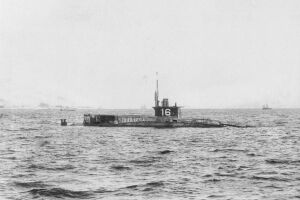Engineering:Ha-7-class submarine
 Japanese submarine Ha-7, in trials off Kure, 1916
| |
| Class overview | |
|---|---|
| Builders: | Kure Naval Arsenal, Japan |
| Operators: |
|
| Preceded by: | Ha-3 class |
| Succeeded by: | Kaichū type |
| In commission: | 1916–1929 |
| Completed: | 2 |
| Retired: | 2 |
| General characteristics | |
| Type: | Submarine |
| Displacement: |
|
| Length: | 43.3 m (142 ft 1 in) |
| Beam: | 4.14 m (13 ft 7 in) |
| Draft: | 3.43 m (11 ft 3 in) |
| Installed power: |
|
| Propulsion: |
|
| Speed: |
|
| Range: |
|
| Test depth: | 30.5 m (100 ft) |
| Complement: | 26 officers and enlisted |
| Armament: |
|
The Ha-7-class submarine (波七型潜水艦 Ha-nana-gata sensuikan) was an early class of submarines of the Imperial Japanese Navy. It was also called the "Vickers C-3 class".[1]
Background
A final two vessels of the British C-class submarine design were built completely in Japan by the Kure Naval Arsenal as part of the emergency expansion of the Imperial Japanese Navy due to World War I. Although the design was considered obsolete by this time, these vessels were felt necessary to meet the perceived threat of German submarine activity in Japanese coastal waters. Physically almost identical to the Ha-3 class, the two vessels incorporated a number of improvements, including a change in the location of the rudder for better control, and the addition of two externally mounted torpedo tubes to double the attack capability from previous designs. Arriving in Japan during the closing stages of the war, neither vessel was ever used in combat.
Ships in class
- Japanese submarine Ha-7 (波号第七潜水艦 Ha-go Dai-nana sensuikan), laid down 1 August 1916; launched 15 March 1916; commissioned 1 November 1916 as 2nd Class Submersible No.16; reclassified as 3rd class submarine on 1 April 1919; renamed Ha-7 on 15 June 1923, decommissioned on 1 December 1929.[2]
- Japanese submarine Ha-8 (波号第八潜水艦 Ha-go Dai-hachi sensuikan), laid down 1 August 1916; launched 15 March 1916; commissioned 2 February 1917 as 2nd Class Submersible No.17; reclassified as 3rd class submarine on 1 April 1919; renamed Ha-8 on 15 June 1923; decommissioned on 1 December 1929.[2]
Notes
- ↑ Chesneau, Roger (1985). Conway's All the World's Fighting Ships 1906–1921.. Naval Institute Press. p. 246. ISBN 0-87021-907-3.
- ↑ Jump up to: 2.0 2.1 Nishida, Materials of the Imperial Japanese Navy
References
- Chesneau, Roger (1985). Conway's All the World's Fighting Ships 1906–1921.. Naval Institute Press. ISBN 0-87021-907-3.
- Howarth, Stephen (1983). The Fighting Ships of the Rising Sun: The Drama of the Imperial Japanese Navy, 1895–1945. Atheneum. ISBN 0-689-11402-8.
- Jentsura, Hansgeorg (1976). Warships of the Imperial Japanese Navy, 1869–1945. Annapolis, MD: Naval Institute Press. ISBN 0-87021-893-X.
- Schencking, J. Charles (2005). Making Waves: Politics, Propaganda, And The Emergence Of The Imperial Japanese Navy, 1868–1922. Stanford University Press. ISBN 0-8047-4977-9.
External links
- Nishida, Hiroshi. "Materials of IJN". Imperial Japanese Navy. http://admiral31.world.coocan.jp/e/stc0507.htm.
 |

